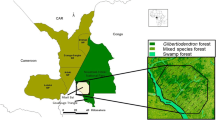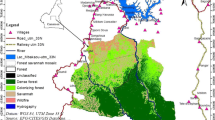Abstract
We examined the relative importance of various botanical and topographical factors that influence nesting-site selection by chimpanzees ( Pan troglodytes schweinfurthii) in the Kalinzu Forest of Uganda. All of them—vegetation type; topographical features; frequency of preferred tree species; frequency of preferred tree size; fruit abundance—significantly influenced nesting-site selection. Fruit abundance and vegetation type had much stronger influences on site selection than the other factors did. In a dense forest environment like the Kalinzu Forest, the local and seasonal distributions of chimpanzee nests seem to reflect the pattern of home range use for feeding.
Similar content being viewed by others
REFERENCES
Anderson, J. R., Williamson, E. A., and Carter, J. (1983). Chimpanzees of Sapo forest, Liberia: Density, nests, tools and meat-eating. Primates 24: 594-601.
Badrian, A., and Badrian, N. (1977). Pygmy chimpanzees. Oryx 13: 463-468.
Baldwin, P. J., Sabater Pi, J., McGrew, W. C., and Tutin, C. E. (1981). Comparisons of nests made by different populations of chimpanzees (Pan troglodytes). Primates 22: 474-486.
Basabose, A. K., and Yamagiwa, J. (2002). Factors affecting nesting site choice in chimpanzees at Tshibati, Kahuzi-Biega National Park: Influence of sympatric gorillas. Int. J. Primatol. 23: 263-282.
Brownlow, A. R., Plumptre, A. J., Reynolds, V., and Ward, R. (2001). Source of variation in the nesting behavior of chimpanzees (Pan troglodytes schweinfurthii) in the Budongo Forest, Uganda. Am. J. Primatol. 55: 45-55.
Fruth, B., and Hohmann, G. (1993). Ecological and behavioral aspects of nest building in wild bonobos (Pan paniscus). Ethology 94: 113-126.
Fruth, B., and Hohmann, G. (1994). Comparative analyses of nest building behaviour in bonobos and chimpanzees. In Wrangham, R. W., McGrew, W. C., deWaal, F. B. M., and Heltne, P. G. (eds.), Chimpanzee Cultures, Harvard University Press, Cambridge, MA, pp. 109-128.
Furuichi, T., Hashimoto, C., and Tashiro, Y. (2001a). Extended application of a marked-nest census method to examine seasonal changes in habitat use by chimpanzees. Int. J. Primatol. 22: 913-928.
Furuichi, T., Hashimoto, C., and Tashiro, Y. (2001b). Fruit availability and habitat use by chimpanzees in the Kalinzu Forest, Uganda: Examination of fallback foods. Int. J. Primatol. 22: 929-945.
Ghiglieri, M. P. (1984). The Chimpanzees of Kibale Forest, Columbia University Press, New York.
Goodall, J. (1962). Nest-building behavior in the free ranging chimpanzee. Ann. N.Y. Acad. Sci. 102: 455-568.
Hashimoto, C. (1995). Population census of the chimpanzees in the Kalinzu Forest, Uganda: Comparison between methods with nest counts. Primates 36: 477-488.
Hashimoto, C., Furuichi, T., Tashiro, Y., and Kimura, D. (1999). Vegetation of the Kalinzu Forest, Uganda: Ordination of forest types using principal component analysis. Afr. Study Monogr. 20: 229-239.
Howard, P. C. (1991). Nature Conservation in Uganda's Tropical Forest Reserves, IUCN, Gland, Switzerland and Cambridge.
Kano, T. (1983). An ecological study of the pygmy chimpanzees (Pan paniscus) of Yalosidi, Rep. of Zaïre. Int. J. Primatol. 4: 1-31.
Kano, T. (1992). The Last Ape, Stanford University Press, Palo Alto, CA.
Krebs, C. J. (1998). Ecological Methodology, 2nd edn., Addison-Wesley, Reading, MA.
Plumptre, A. J., and Reynolds, V. (1996). Censusing chimpanzees in the Budongo Forest, Uganda. Int. J. Primatol. 17: 85-99.
Plumptre, A. J., and Reynolds, V. (1997). Nesting behavior of chimpanzees: Implications for censuses. Int. J. Primatol. 18: 475-485.
Sept, J. M. (1992). Was there no place like home?: A new perspective on early hominid archaeological sites from the mapping of chimpanzee nests. Curr. Anthropol. 33: 187-207.
Tutin, C. E. G., and Fernandez, M. (1984). Nationwide census of gorilla (Gorilla g. gorilla) and chimpanzee (Pan t. troglodytes) population in Gabon. Am. J. Primatol. 6: 313-336.
Wrogemann, D. (1992). Wild Chimpanzees in Lopé, Gabon: Census Method and Habitat Use, Phd Dissertation, Bremen University, Germany.
Author information
Authors and Affiliations
Corresponding author
Rights and permissions
About this article
Cite this article
Furuichi, T., Hashimoto, C. Botanical and Topographical Factors Influencing Nesting-Site Selection by Chimpanzees in Kalinzu Forest, Uganda. International Journal of Primatology 25, 755–765 (2004). https://doi.org/10.1023/B:IJOP.0000029121.25284.7f
Issue Date:
DOI: https://doi.org/10.1023/B:IJOP.0000029121.25284.7f




